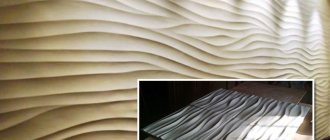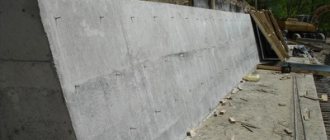The question of why marble is made from concrete could probably only be asked by some ancient ruler, for whom this luxurious building material was mined and brought by slaves, and completely free of charge. In modern times, real marble, given the cost of its difficult extraction and delivery from the deposit, is not affordable for everyone. Meanwhile, today, as in ancient times, the external or internal decoration of a building with marble gives it a magnificent, noble, even regal appearance. Therefore, it is not surprising that our practical contemporaries, armed with new technologies, have learned to make artificial marble from concrete. And, as it turned out, this does not require large industrial capacities and indeed no serious production at all. It is quite possible to make such building material at home and with your own hands.
It is made using different techniques, as a result of which the resulting material is called differently: decorative (or colored) concrete, systrom, artificial marble, etc. When making decorative concrete, for example, marble chips of a certain shade are sometimes added, which allows give the material a unique “marble” pattern. However, the principle and essence of the production technology do not change: despite the different names, they are the same material.
Preparation
Before you make marble from concrete, you need to do some preparation. To do this, you should ensure that you have:
- pigment;
- cement;
- sand;
- plasticizer.
The latter is a substance that improves the characteristics of the material. To make marble you will need molds. For this you can use those made on the basis of polymers. If you cannot find any, then you can use plastic forms. But for the solution you will need cement grade M 500. When choosing a pigment, you can give preference to oil paint. It is presented in many shades.
Tips for working with white cement
To protect reinforced white concrete from rust, you need to follow some simple rules:
- Iron elements must lie at a depth of at least 3 cm from the surface.
- Before pouring, treat the reinforcement bars with anti-corrosion agent.
- They should also be covered in advance with a thin layer of cement mortar and allowed to dry.
For colored compositions based on white cement, there is also an important condition: the concentration of pigment in the solution should be no more than five percent. And you shouldn’t add more sand than necessary - it dulls the colors.
Types of concrete for marble
The production of artificial marble from concrete may involve the use of different types of mixture. The latter is a composition of aggregate, binder and water. Mixing the components can also be done in a concrete mixer if the amount of work is quite impressive. Taking into account different criteria, it is possible to classify the concrete mixture for marble by density.
You can get heavy, very heavy, light and very light material. In the first case, we are talking about grades in the range M 100-M 600. Lightweight concrete will correspond to the following grades: M 35-M 400; very heavy and very light concrete for marble corresponds to grades M 100-M 200 and M 25-M 200. In order to prepare a product with high strength, it is better to prefer concrete grades M 400 or M 500. The density of the concrete mixture will vary from 1800 up to 2500 kg/m2.
Nuances of operation
This is especially true for stone used in exterior decoration, since water-acrylic varnish is not affected by sunlight.
As a result, the marble decorative element will not change its color and will not become covered with unpleasant yellow spots for 10-15 years.
Falling heavy objects with sharp corners can damage the marble. Do not cut food directly on the countertop; use cutting boards.
It is also recommended to cover artificial marble with a concrete primer at least once a year after cleaning. In this case, it will last much longer.
Materials and tools
If you decide to make marble yourself, you should ensure that you have special tools and materials. For this you will need:
- polyethylene film;
- water;
- Oil paint;
- fine sand.
When preparing paint, you must take into account the shade of the material that you will end up with. The filler can be gravel or small pebbles. M 400 grade material is sometimes used as cement. For mixing, you should prepare a container and a drill. The latter should have a mixer attachment.
Commercial offers
If you are a manufacturer or supplier of equipment, an expert or a franchisee in this field, then write to us through the Contact page. Below we will post information about your offer and your contacts.
The page publishes only reviews that are useful to others and indicate that the person had experience in this matter.
Thank you very much in advance if you share your precious experience with our readers! :)
Composition and characteristics of marble preparation
If you decide to make marble from concrete, then it is best to ensure that you have a vibrating table, which you can rent. For the solution you will need two parts sand and part cement. The ingredients are mixed until smooth, and then the pigment is added. It can leave stains characteristic of marble.
You can experiment by adding paints of different shades. After filling, the form is shaken, and if there is a vibrating table, it is placed on it. By the way, you can make a vibration table yourself. It can also be useful for making paving slabs. The last stage of making marble from concrete is the most labor-intensive.
It involves grinding. After the molds have dried, the products must be processed. This creates quite a lot of dust, so you should take care of several buckets of water in advance. An alternative solution is to connect a hose with good water pressure.
Advantages of white cement
There are several advantages over the usual:
- looks better on its own;
- it also does not hide the color of pigments that can be added to it;
- the solution hardens quickly (60% after 16 hours);
- more durable due to fine grinding;
- therefore it adheres well to other materials;
- allows you to add less chemicals to the composition, which means it is more environmentally friendly;
- sulfate-resistant (not corroded by acids in groundwater and sediments).
Compared to conventional cement, it has no disadvantages, except for its higher cost. But its advantages allow it to expand its scope of application.
Technology requirements
Concrete marble can turn out no worse than natural stone. However, technology must be followed. Even window sills can be made from marble, but for this you need to find plastic trays. You can complete the forms yourself. To do this, the plastic panels are fastened together. Using the same technology, polymer concrete can also be produced, but instead of cement in this case, binders in the form of thermoactive resins will be used. Among them:
- furan;
- phenolic;
- epoxy.
When making polymer concrete, a larger amount of filler is added to the ingredients than when making conventional concrete mortar.
general information
Scheme of the grain composition of marble.
But only a person wants to decorate his life. This is a spiritual need. We also take building materials from nature - stone, sand, clay. Unprepossessing in appearance, after processing they become original and pleasing to the eye.
Igneous granite and basalt and sedimentary limestone and marble are suitable not only for construction, but also for design. Satisfying the need for beauty and grace, we decorate houses with them, pave facades, and line walls.
Sink to sink, high temperature and compaction created a unique biological building material - chalk, limestone, marbled limestone and marble. It is everywhere where the ocean was, of different colors and densities. The rarest of them is marble. There is little of it in nature. Its deposits are located in the mountains, where it is difficult to deliver the necessary equipment. Extraction, processing and transportation make the cost of this material quite high. In addition to costs and limited supplies, there is an ethical side to the issue - this is consumerism, the destruction of natural resources. We are building one monument, destroying another, natural one. Today, thanks to the new technology “marble from concrete”, we can save natural resources.
Expert recommendations
Concrete marble technology may look slightly different. As a proportion, you can use the standard ratio of one to three. The filler in this case will be calcium carbonate or other neutral fillers. If you decide to prepare polymer concrete, then the solution is combined in proportions of one to four. The fillers will be coarse-grained materials. For these purposes, you can use crushed gravel or coarse sand. The materials for this are:
- quartz;
- limestone;
- sandstone;
- dolomite.
When making artificial marble from concrete, it is not enough to prepare the solution correctly. It is important to follow other stages of the technology. For example, after pouring the mixture into molds, the surface is covered with plastic film. In order to achieve higher strength of the material, it is reinforced with wire.
As soon as the mixture is poured into molds, a reinforcement cage must be placed inside. After the mixture has hardened, the products are removed from the mold and sanded. To do this, you can use diamond discs in the form of cups or a grinder. After performing this operation, the surface should be smooth, thereby resembling natural marble.
Manufacturers of white cement
Let's compare white cement from three well-known manufacturers.
Aalborg White
This company has factories not only in Denmark, but also in the USA, Malaysia and Egypt. They produce super white cement with low alkali content. This cement also has a low content of SZA (a type of mineral substance), and therefore has high sulfate resistance. The most durable of those presented.
Aalborg White cement can be used to prepare a colored mixture for finishing work. Cornices and other figured elements in the form of stucco molding are made from concrete based on it. It performs equally well as decorative cement and as a component of high-strength concrete, which requires wear resistance and moisture resistance (pavement slabs, swimming pools, etc.). This cement can be stored in a dry place for 6 months.
Cimsa
This Turkish brand is the largest producer of white Portland cement, which is also successfully used in industrial construction. White cement M600 from Cimsa is not as strong as M700 from Aalborg, but it fully complies with Russian GOST 965-89. It is moisture and frost resistant enough to be used outdoors in our climatic conditions. Light reflection indicators (whiteness) are somewhat lower, but the cost is lower.
Holcim (“Shchurovsky Cement” and “Volskcement”)
Holcim - Swiss and JSC Volskcement - are Russian factories that officially produce cement under the Holcim brand. They make white cement using “dry” and “semi-wet” methods; laboratories strictly control its quality at all stages of production.
For Russian production of white cement, M500 is the highest strength grade. We compared this particular brand of cement with dry cement mixtures manufactured abroad:
For those who have started a large-scale construction project, the difference in price will be noticeable. Holcim is not much inferior in performance to Aalborg or Cimsa. In the end, the whiteness and strength of the mortar depends not only on the cement, but also on the aggregate, as well as on compliance with the mixing technology. But if we are talking about important decorative elements, then it may be better to choose an imported analogue so as not to spoil the appearance.
All you have to do is choose according to your goals and wallet. And if you have your own preferences, share them in the comments and let’s discuss.
Source
More about technology
You know the composition of concrete marble if you read the article. It is also important to take an interest in the features of the technology. In the process of such production, it is possible to obtain artificial marble, which is also called colored or decorative concrete, as well as systrum. However, these are just different variations of names that are combined into one technology.
It has absorbed all the advantages of the semi-dry forming technique and the vibration casting technique. This allows you to make a material that will be identical to natural marble. The components are the most affordable and simple. In general, decorative concrete is ordinary, but white shades of cement are added to it, which gives the products a noble appearance.
Sometimes the production of marble from concrete involves the use of special fillers, including marble chips. It can have a variety of shades and colors. This approach is combined with subsequent processing. The surface must be polished to achieve the effect of real marble. In addition, the final stage allows the structure of the aggregate to be attractively revealed.
Areas of application of white cement
Firstly, color fastness in direct sunlight and resistance to atmospheric moisture make white cement ideal for outdoor conditions. It is used as a finishing material for facades - terrazite plaster, for example, contains mineral particles and looks like natural stone.
This type of cement can be part of white concrete, from which decorative elements are made - columns, steps, borders, flowerpots. By adding pigments, you can achieve rich colors, create original paving slabs or decorative bricks, the same colored plaster or contrasting grout for brickwork. The possibilities here are unlimited.
As for the physical properties of the mixture, it is fine-grained, and therefore ideal for grouts and adhesives.
How and in what volume to add water?
After the dry ingredients have been combined, you can add them to the water. Combine it with the components in a ratio of one to two. First, pour in 80% of the liquid and mix everything well. Then a plasticizer is added, which increases the strength of the product.
This component will make up 1% of the total mass. Afterwards the mixture is mixed well and left for 10 minutes. During this time, the composition becomes plastic and viscous. Only after this can you pour in the remaining water.











